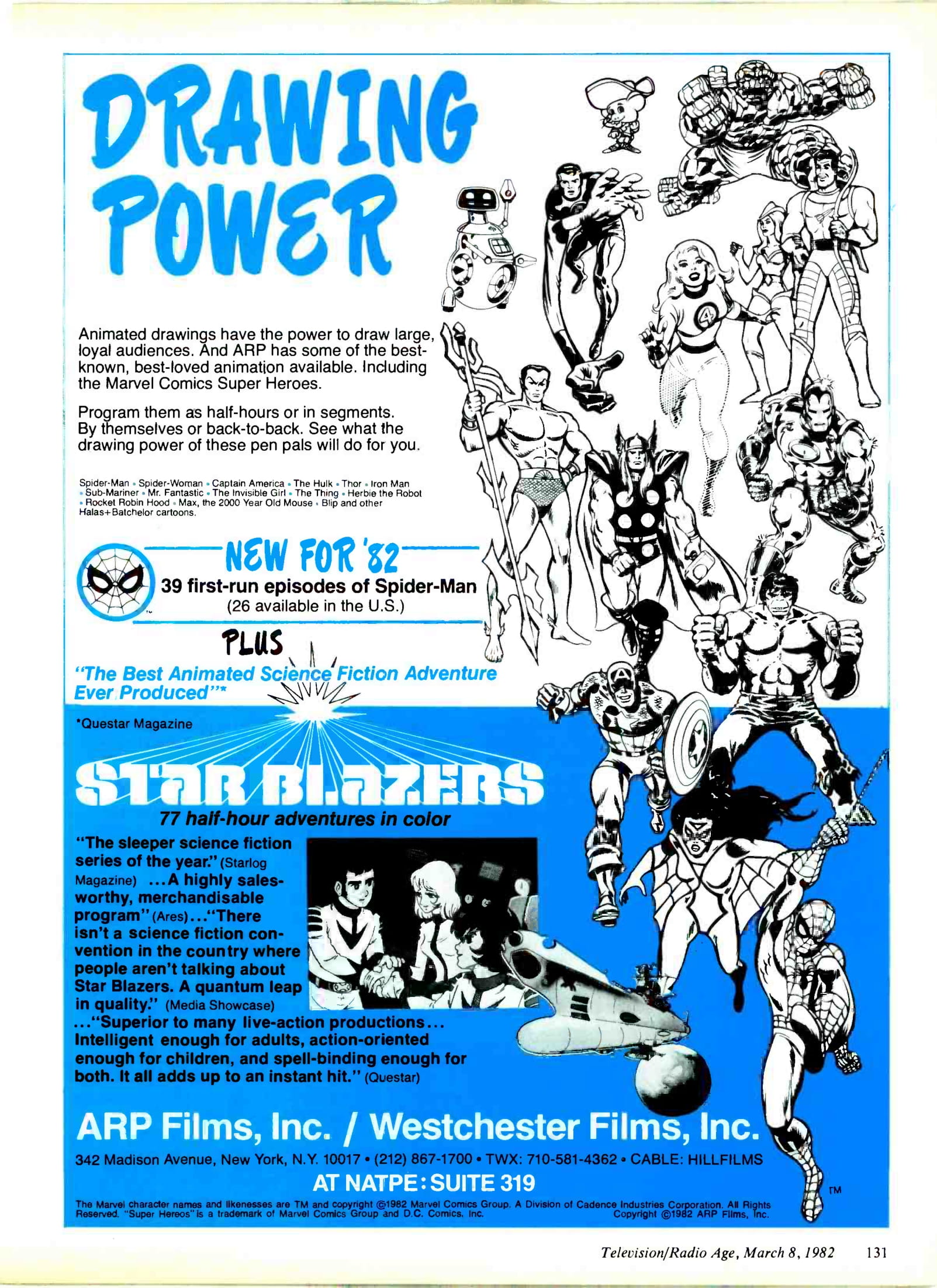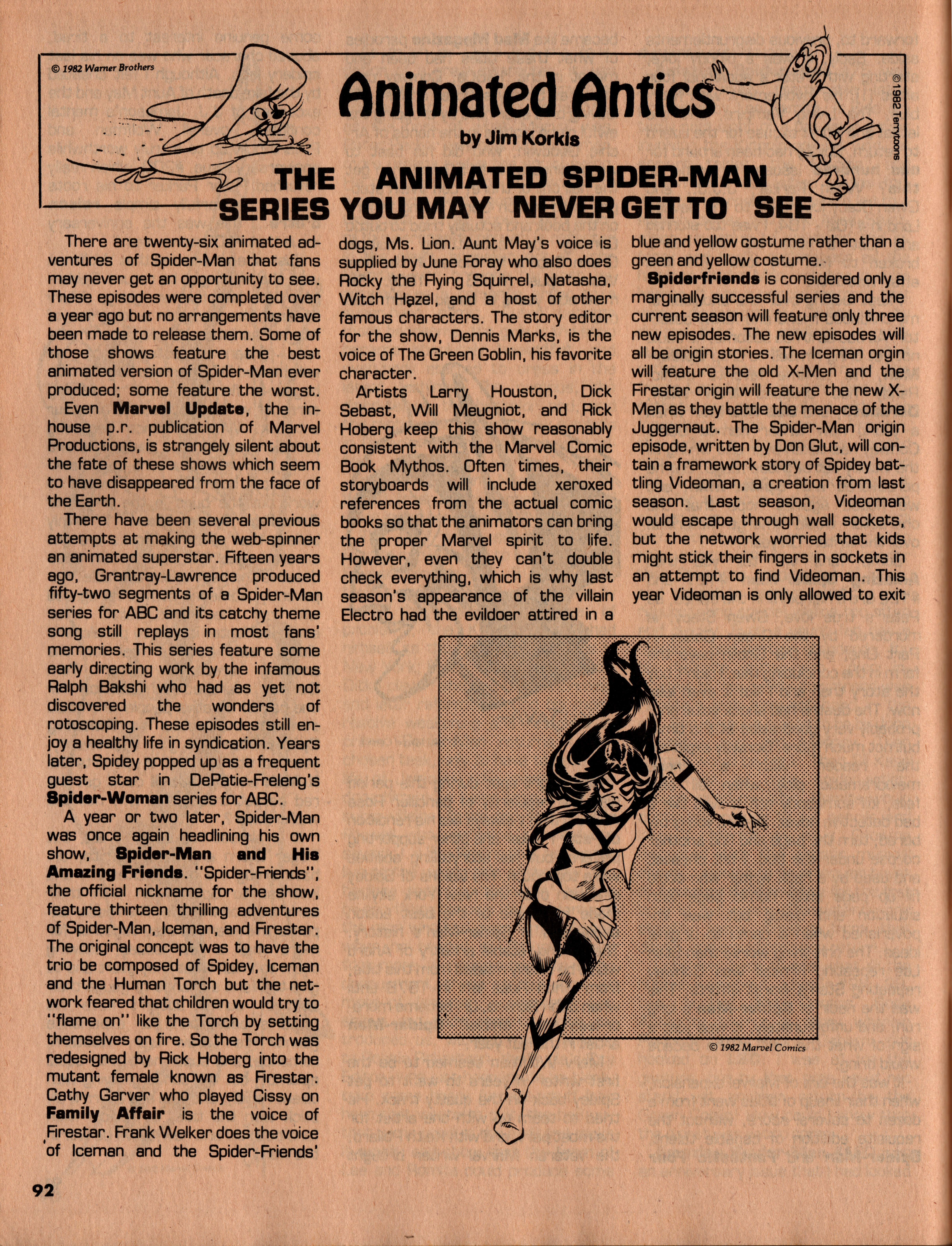How the 1981 solo Spider-Man cartoon was
the third Spider-Man animated series to air
Among the many Spider-Man animated series that
have been produced since the late 1960s, by far the most seldom-seen and
obscure of those shows is the series simply entitled "Spider-Man",
made by Marvel Productions. The series, commonly referred to as the "1981
solo Spider-Man cartoon", is often confused with 1981's Spider-Man
and His Amazing Friends. Though the solo Spider-Man cartoon
began production before Amazing Friends, it didn't actually air until
much later. And it didn't air at all in 1981, the year it was copyrighted.
The distribution history of the 1981 solo Spider-Man
cartoon plays a key part in why the series has so often been overlooked. To
understand the background behind this, it is important to recap the early
history of Marvel Productions.
DePatie-Freleng to Marvel Productions
In the late 1970s, DePatie-Freleng Productions,
most famous for their work on the Pink Panther series of
cartoons, produced two animated television shows based on Marvel Comics
characters, namely The (New) Fantastic Four in 1978 and Spider-Woman
in 1979. In late 1979, the company began pre-production on a new Spider-Man
animated series. However, shortly thereafter, on February 6th 1980, it was
reported that DePatie-Freleng Productions was to be dissolved.[1]
The company's assets were subsequently acquired
by Marvel Comics by June 19th 1980, when the formation of Marvel Productions
was reported on.[2] One of the reasons behind Marvel Comics founding
their own animation studio was to ensure that any future series they produced
featuring Marvel Comics characters would remain true to the spirit of the
original comics thanks to the presence of Stan Lee as Marvel Productions'
Creative Director.[3]
To that end, production of the proposed new Spider-Man
series that had begun pre-production at DePatie-Freleng was resumed by Marvel
Productions. It was determined that the new Spider-Man series would eventually
be offered as a package with the 1967 Spider-Man cartoon in future
syndication.
This decision resulted in certain aspects of
the series, the 1981 solo Spider-Man cartoon, being deliberately
patterned after the 1967 Spider-Man cartoon, including the presence of
Betty Brant (a regular character in the 1967 Spider-Man show, but who
had been written out of the comics in late 1979), and also visual elements such
as Peter Parker in his civilian identity wearing a blue jacket and yellow
turtleneck sweater that he wore in later episodes of the 1967 cartoon.
Additionally, according to an account from the
Producer and Story Editor of Spider-Man and His Amazing Friends, Dennis
Marks, the 1981 solo Spider-Man cartoon was wholly funded by Marvel Comics,
partially with the intent of gaining NBC's interest for purchasing a Spider-Man
show from Marvel Productions.
NBC agreed to purchase a new Spider-Man based
series from Marvel Productions that incorporated their desired demographic
requirements for a Saturday morning network show. The resultant series, Spider-Man
and His Amazing Friends, first aired on September 12th 1981.
However, although the 1981 solo Spider-Man
cartoon had also been completed by the end of 1981, as stated in the opening
paragraph of this article, it did not air that year.
The 1981 Spider-Man cartoon, first offered
in...1982?
|
The earliest known trade ad for the 1981 solo Spider-Man
cartoon, from March 1982, indicates that it was offered for syndication
alongside episodes of the 1967 Spider-Man series by ARP Films and was
specifically described as being "New for '82." International
packaging of the series also included the first season of Spider-Man and His
Amazing Friends, reflecting original broadcasts of both series in the U.K.
in the mid-1980s, where episodes of both shows were mixed together.[4] |
 |
|
Early sales of the show into syndication may
have been either sluggish or non-existent, since, in the latter-half of 1982,
Comics Feature #22, cover-dated December 1982, published an article on
"The Animated Spider-Man Series You May Never Get to See." This
article was likely the first time fans discovered that Marvel Productions had
created another Spider-Man series, separate to Spider-Man and His
Amazing Friends. |
 |
The article related the production of the 1981
solo Spider-Man cartoon, while also specifically noting that it had not
been aired at the time of writing - this was likely some time before The
Incredible Hulk and the Amazing Spider-Man began on September 18th
1982, as the three Amazing Friends episodes for that season are
described as not having yet aired.[5]
The following year, in March 1983, ARP Films
took out another trade ad, mostly identical to the one from a year earlier, but
with the addition of the three episodes from Spider-Man and His Amazing
Friends' second season for international distribution only.[6]
ARP Films and Marvel, a rocky relationship
From 1968, ARP Films were the distributor to
all of Marvel Comics-based animation series, with the exceptions of the 1967 Fantastic
Four and (Fred and Barney Meet) The Thing, which both remained with
Hanna-Barbera. ARP Films also had an agreement with Marvel Productions that
they would distribute the new "first-run" 1981 solo Spider-Man
cartoon on a commission basis.
The Comics Feature article and ARP Films ads
together conclusively prove that, while produced in 1981 before Spider-Man
and His Amazing Friends, the 1981 solo Spider-Man cartoon did not in
fact air until later.
With 26 completed episodes and a distribution
company in place, why therefore was the 1981 solo Spider-Man cartoon
initially so obscure? There are several factors that undoubtedly played a part.
With the series sharing an identical title to
its 1967 predecessor that it was syndicated alongside, it is not unreasonable
to assume many viewers simply skipped what they believed to be re-runs. One
account suggests episodes of the 1981 Spider-Man cartoon aired in
Connecticut in 1983. According to at least one other account, a stripped
broadcast of Spider-Man episodes in 1984 consisted of two episodes of
the 1967 series followed by three episodes of the 1981 solo Spider-Man
cartoon (two standalone episodes followed by an episode from the "Doom-Saga").
Even among viewers who did see episodes of the
series in the early 1980s, there was, and remains, much confusion between the
1981 solo Spider-Man cartoon and Spider-Man and His Amazing Friends
due to the many shared assets between both series, including character designs,
background music, and some of the voice actors.
Perhaps the most important factor impacting
awareness of the series was Marvel Productions' relationship with ARP Films
themselves, which began to deteriorate in 1981, just as preparation for selling
the 1981 solo Spider-Man cartoon into syndication was to begin.
With the home video market beginning a new age
at the dawn of the 1980s, Marvel partnered directly with other distributors to
release video tapes featuring episodes of past Marvel animated series. This was
a decision that did not sit well with ARP Films, who insisted that, in addition
to television distribution rights, they also had home video distribution rights
to Marvel's animated shows as well.
|
Ironically, perhaps with some awareness of the
television distribution problems the 1981 solo Spider-Man cartoon faced, Marvel
Productions partnered with Prism Entertainment to create the Marvel
Comics Video Library, an extensive series of video tapes from past
Marvel Comics-based series, the first eighteen volumes of which were released
on September 17th 1985, with a second set of six tapes released the following
year. Included on eleven of those tapes were eleven specially-selected episodes
from the 1981 solo Spider-Man cartoon. |
 |
In-between both sets of Marvel Comics Video
Library tapes, Prism Entertainment also released a special compilation
movie of several of the "Doom-Saga" episodes of the 1981 solo Spider-Man
cartoon entitled "Dr. Doom Conquers the World". According to Larry
Parr, the writer of the Doom-Saga episodes, this compilation movie was at one
point intended for theatrical distribution in Europe and syndicated as a television
movie domestically.
The resulting fallout between ARP Films and
Marvel regarding home video distribution rights led to legal action between
both companies, and, by September 1987, Marvel completely terminated their
agreement with ARP Films to distribute any of their animated series for
television.[7]
Having been freed from the distribution dispute
between Marvel and ARP Films, this finally allowed the 1981 solo Spider-Man
cartoon, alongside episodes of Spider-Man and His Amazing Friends, to
achieve wide television distribution as part of the Marvel Action
Universe, a syndicated cartoon block that began airing on October 1st
1988. For many fans, this was the first time they were able to watch the
series.
ARP Films eventually served a lawsuit against
Marvel Entertainment Group regarding the dispute over home video distribution
rights, and the case subsequently went to trial in 1989. It was ultimately concluded
by the jury that Marvel had indeed breached their original contract with ARP
Films and that ARP were to be awarded $1,220,000 from Marvel.[7]
Selling solo Spider-Man
That the 1981 solo Spider-Man cartoon
had an identical on-screen title compared with its 1967 predecessor,
understandably caused problems in differentiating both series for prospective
buyers. For the purposes of distribution as a separate series, the show was, by
1983, simply offered under the title of "New Spider-Man."[8]
By the 1992, the series had begun to be offered
as "Spider-Man 5000" by Marvel's then-owners, New World
Entertainment, which would serve to cause confusion for many years.[9]
The "5000" never originally appeared on, nor was added to, the
series' title screen, and was simply a reference to the series' production code
of #5000 (whereas Spider-Man and His Amazing Friends was production code
#6000).
The 1981 Spider-Man cartoon's obscurity
persists to this very day, but thanks to the internet, and as more information
on the series is uncovered, it is much easier to illustrate the differences
between it and the more famous Spider-Man and His Amazing Friends.
References
[1] Daily Variety (February 6, 1980)
[2] The Hollywood Reporter (June 19, 1980)
[3] Comics Feature #33 (January-February 1985)
[4] Television/Radio Age (March 8, 1982)
[5] Comics Feature #22 (December 1982)
[6] Television/Radio Age (March 14, 1983)
[7] Arp Films, Inc. v. Marvel Entertainment Group, Inc., 905 F.2d 687, 689 (2d Cir.1990)
[8] Broadcasting (March 14, 1983)
[9] Broadcasting (January 13, 1992)
v3 4/15/2022

![]()